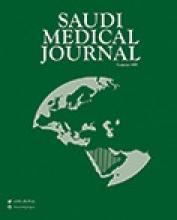Abstract
OBJECTIVE: Impacts of air pollution on the human health have been recognized over the last decades. Smokes, in particular, have deleterious effects on the respiratory system. According to a local tradition, incense "Bakhour" is burnt and the resultant heavy smokes are inhaled. The objective of the present study is to investigate the ultrastructural pulmonary changes which can be induced by Arabian incense, Bakhour, exposure.
METHODS: The study was conducted from September through to December 2003, at the Animal House, College of Science, King Saud University, Riyadh, Kingdom of Saudi Arabia. Two groups of Wister albino rats, Rattus norvegicus, were used. One group (n=16) was exposed to 420 grams of Bakhour for 14-weeks at the rate of 4 grams/day in the exposure chamber. Additional group of rats, of equal number, was used as non-exposed control. At the end of the exposure period, lung tissues were removed from all experimental animals and processed for electron microscopy.
RESULTS: Alveolar pneumocytes of exposed animals revealed significant ultrastructural changes which involved the cell organelles and surfactant material of type II cells. Hyperplasia of alveolar cells was a feature in the affected lung tissue. Neutrophils were recognized infiltrating pulmonary alveoli and accompanied with degenerative and necrotic changes of the alveolar cells. Deposition of collagen fibrils in the alveolar walls was also observed.
CONCLUSION: Basing upon the results of electron microscopy, it was concluded that exposure to Bakhour can induce ultrastructural pulmonary changes which may imply compromised respiratory efficiency.
- Copyright: © Saudi Medical Journal
This is an open-access article distributed under the terms of the Creative Commons Attribution-Noncommercial-Share Alike 3.0 Unported, which permits unrestricted use, distribution, and reproduction in any medium, provided the original work is properly cited.






